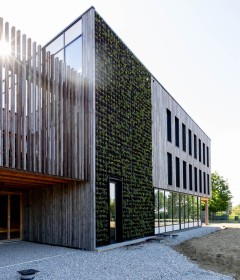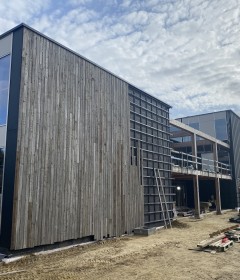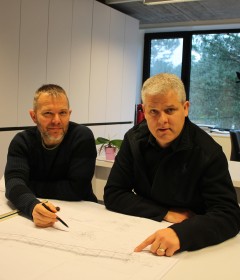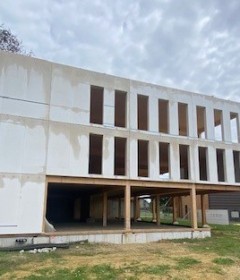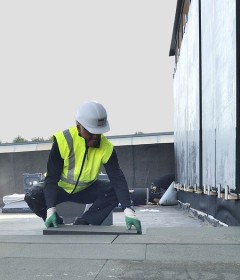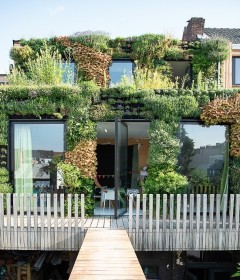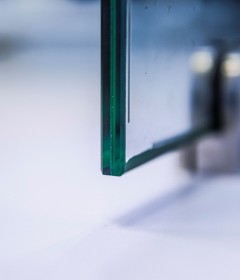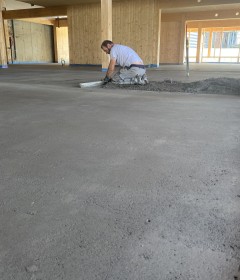26 augustus 2021
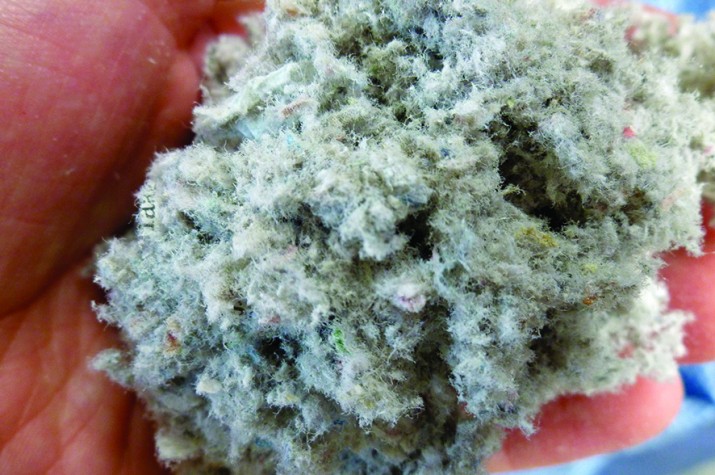
Cellulose is the main insulating material that was used for the façades of ’t Centrum. This type of insulation is made from old, recycled newspapers. Why did the construction team opt for this insulation and what are the advantages? We discuss this in more detail in this article.
Cellulose pulp is an eco-friendly, bio-based insulation material. This insulation material has a thermal conductivity value ( = λ value = lambda value) in the range of 0.035 and 0.04 W/mK, putting it in the same category as mineral wool or polystyrene products. What’s more, cellulose insulation scores a lot better in terms of renewability and recycling.
Cellulose insulation is made from old, unsold or misprinted newspapers. The paper fibres are extracted from the papers during the production process. These fibres interlock to form elastic flakes that feel like cotton wool. There are small air pockets between the interwoven fibres. The still air inside these cavities make cellulose an insulating material.
Cellulose insulation comes in two forms. The most common form are the ‘loose’ paper flakes. These are blown into hollow compartments (such as between rafters and grids) to form a continuous layer, encapsulating any shapes and perforations. That way you avoid cracks and crevices and heat loss. But you can also buy compressed cellulose mats. Like mineral wool, these mats can be clamped in between the rafters of your roof structure.
Ecological
Cellulose insulation is considered eco-friendly for several reasons.
Firstly, the raw material of paper, i.e., wood, regrows, making it an inexhaustible resource. Cellulose mats also require support fibres to achieve good stiffness and mechanical resistance. Usually natural fibres such as hemp are used for this.
Secondly, cellulose insulation has additional benefits because it is largely a recycled material. Wood - and paper - also stores carbon as opposed to emitting it. The longer we keep this CO2 in circulation, the longer it takes for it to be released back into the atmosphere.
When you use blow-in cellulose insulation, as is the case at ‘t Centrum, you not only create a seamless insulation layer without cracks and crevices, but you also avoid loss and cutting residues during installation.
Furthermore, when the building is demolished, the cellulose insulation can be reused in a subsequent project, even if the dimensions are completely different and the shapes are more complex. The cellulose can also be reintroduced into the production line. In other words, they can be used in a circular way.
Finally, the cellulose that was used in this instance has an ecological advantage. The cellulose that was used at ‘t Centrum is produced in Belgium, limiting the transport distance. In addition, the raw materials were sourced locally within an average radius of 257 km. The production energy is very low (it is among the lowest in the insulation materials industry) and uses 100% green energy.
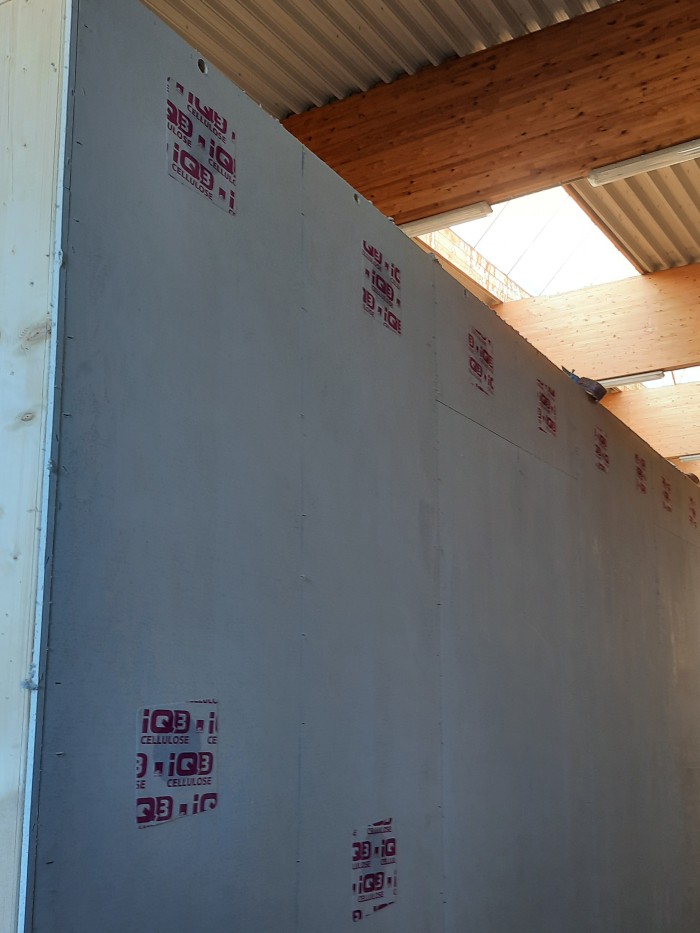
Circular cellulose at ‘t Centrum
At ‘t Centrum cellulose is blown into the prefab timber frame walls.
“Cellulose is a recycled product. It is installed loose (blown in) ensuring that it is also removable, reusable and recyclable”, Dirk Verbeeck, an architect at Kamp C, explains. “At ‘t Centrum, circularity is also guaranteed at the elemental level. The prefab façade section, including the cellulose, is a standard element that can be reused integrally in a new building.”
Was cellulose solely chosen for its ecological and circular properties?
You already known that the lambda value of cellulose insulation is the same or better than that of conventional insulation materials. But there's more:
1. Good moisture regulation against building damage and mould: Cellulose insulation can absorb up to 20% of its own weight in moisture without losing its insulating effect. This makes cellulose very suitable for the temporary storage and evacuation of existing moisture from construction elements (or any undesired moisture infiltration that must absolutely be avoided).
The moisture in the construction is thus well regulated, reducing the risk of mould and rot in the construction. Despite the fact that cellulose can easily absorb and release moisture, it is not recommended to use cellulose insulation in wet construction elements (such as a cavity wall).
2. Fire resistance: Even though cellulose insulation is made from paper fibres, it does not immediately catch fire. In the event of fire, cellulose insulation burns like a phone book rather than a single sheet of paper. In addition, a protective char is formed the cellulose. This charred layer provides protection for wooden structures, ensuring that wooden beams are not harmed by fire. This is further enhanced by additional additives that act as flame retardants.
3. Resistance to pests: The dusty character of cellulose insulation and its additives are annoying and therefore repel vermin and insects. Its elasticity and structure are also unattractive to rats and mice.
4. Soundproofing: Cellulose insulation, like all mat-like materials, has a good sound reduction index of ±50 dB. It can therefore be used in roofs and partitions to dampen environmental noise. Because cellulose insulation is not pressure-resistant, it can be used in hollow wooden floors but sound will still travel through it. Other materials are used for this, as part of a floating floor.
5. Summer heat protection: In winter, cellulose insulation retains heat well whereas it keeps heat out for longer on hot days. In insulation phase shift refers to how long it takes for the (outside) temperature to travel through an insulating material. It will take considerably longer before the heat/cold reaches the inside of your house if it is insulated with cellulose insulation, compared with the same thickness in glass wool. Meaning the summer heat only enters the cellulose when the outside temperature has dropped, and night ventilation can be actively used. It is worth noting that this has less of an impact than good sun protection, avoiding cracks and crevices, ... Even during heat waves when temperatures remain very high at night, the effect is netted out somewhat.
6. Versatility: Cellulose insulation can be used for interior and exterior insulation in new-builds and renovation projects. It is suitable for roofs, walls and (attic) floors. At ‘t Centrum, cellulose is used for the prefab timber frame walls.
7. Eco-friendly and sustainable: Because cellulose insulation material is mainly made from old newspapers and the number of additives is very limited, the production process only has a minimal environmental impact and a lot of waste and new material is saved. We already discussed the other ecological benefits above.
Other insulation materials for specific applications
Extruded polystyrene foam from Jackon was used for the outside of the plinth of ‘t Centrum in the waterlogged area. This is also 100% reusable because it can be processed.
For roof insulation, we needed a pressure-resistant material at ‘t Centrum, which significantly reduced the range of available materials. The designers therefore used pressure-resistant rock wool insulation (Rockwool Caproxx) for the roof. “Our first choice was wood fibre insulation, but this was no longer available due to the coronavirus pandemic”, contractor Joeri Beneens explains. Rockwool is a circular material because it can be processed. The loose insulation is perfectly reusable. This would have been no different for any other pressure-resistant sheet material. But (pure) rockwool is also recyclable and of mineral origin. Rock wool is not sufficiently compression-resistant under the terrace of the offices, which is why the designers elected to use Foamglas. This is made from 60% recycled glass
The loose insulation and roof covering combine to create a ballast layer. This will also protect the roof covering against direct sunlight, providing improved comfort during the summer months.
Acoustic insulation is less relevant for roofs, although it does help with airborne noise. However, acoustics are especially important between two building layers because of contact noise.
The floor insulation at ‘t Centrum consists of shells. The layer of Ecoshells is 60 cm thick. Because the shells do not have a very good insulation value, you need to use a thicker layer.
More information: www.beneens.be and www.isoproc.be
Photos: © Isoproc cellulose pulp at ’t Centrum

